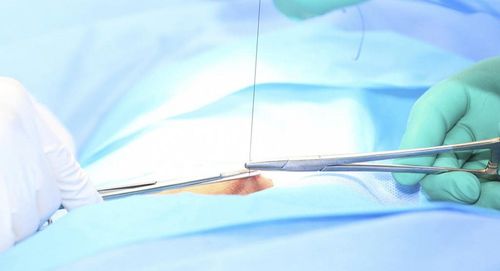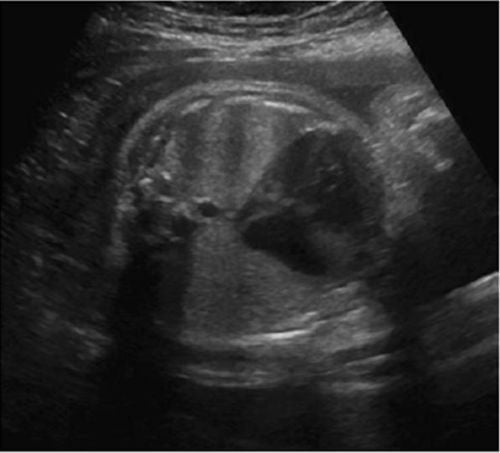This is an automatically translated article.
The article was professionally consulted by Specialist Doctor I Le Hong Lien - Department of Obstetrics and Gynecology - Vinmec Central Park International General Hospital.Vascular vasculature is a rare complication in pregnancy with an incidence of only 4/10,000 cases. However, this is a very dangerous complication that can take the life of a newborn if not diagnosed and treated promptly.
1. What is the vasculature of the vasculature?
Vasa previa is a condition in which the fetal umbilical cord blood vessels run across or lie close to the opening of the cervix. These blood vessels are located in the membrane, not protected by the placenta or the umbilical cord, so the blood vessels of the umbilicus are easily broken, causing the fetus to lose a large amount of blood. If severe bleeding occurs, the fetus can die and the mother's life can be in danger.This is a rare obstetric complication with a rate of only 1.5-4/10,000 cases. According to statistics, up to 56% of cases of ruptured blood vessels in the prostate are not diagnosed early before labor, leading to stillbirth.
About the mechanism of causing complications: Normally, the blood vessels feeding the fetus are protected by the Wharton jelly located in the umbilical cord. However, the vas deferens are not supported by this jelly or the vasculature is adherent to the upper chorion, which is easy to tear during spontaneous rupture of membranes or amniotomy. More dangerously, the blood flowing from the blood vessels of the vas deferens is the blood of the fetus, so it can threaten the life of the child if there is no timely emergency intervention.
However, if vasculopathy is detected during pregnancy, the chance of fetal survival can be increased up to 97%. Even so, babies can still have complications from being born prematurely, such as low birth weight or underdeveloped lungs.

2. Causes of varicose veins
The causes of varicose veins are as follows:Prolapse of the umbilical cord: A condition in which the umbilical cord enters the membrane, leaving the blood vessels unprotected by the placenta; The placenta is divided into 2 pieces: The blood vessels are unprotected at the junction of the 2 lobes; In addition, other factors increase the risk of varicose veins such as: Multiple pregnancy, history of caesarean section, in vitro fertilization, low placenta previa, placenta previa, history of dilation curettage. have had previous uterine surgery.

3. Symptoms of vasculitis of the striker
Vascular presbyopia often has few early symptoms and is only discovered during labor. However, there are some warning signs of this condition that pregnant women should not ignore:Painless vaginal bleeding: Due to rupture of fetal blood vessels in the second or third trimester of pregnancy. If this phenomenon occurs, pregnant women may see dark, burgundy blood because the fetal blood has a lower amount of oxygen than the mother's blood; The fetal heart rate is abnormally slow when blood vessels burst and begin to bleed.

4. Diagnosis of the phenomenon of blood vessels in the prostate
Vesicular vasculature can be diagnosed by transducer ultrasound combined with Doppler ultrasound. Doctors recommend performing a transvaginal ultrasound scan for high-risk pregnant women, especially mothers who have been diagnosed with placenta previa or have warning signs of this phenomenon. Early diagnosis will help doctors take timely interventions, ensure a safe and healthy birth, and reduce the risk of complications for the mother.5. Methods of vascular treatment of the striker
There is no measure to prevent the condition of blood vessels in the prostate, but pregnant women can prevent complications of the disease if they have regular antenatal check-ups, timely diagnosis and treatment before giving birth. Monitoring and treatment include:Regular ultrasound to monitor fetal development, ensure blood vessels do not burst or bleed; To give the pelvis a rest, do not have sex, do not put anything in the vagina except for an ultrasound. At the same time, pregnant women should rest a lot, avoid overwork or exercise; Hospitalization at 30 - 32 weeks to closely monitor the health of mother and baby; Steroids can be used to help the baby's lungs mature faster if needed for an early birth; Using antispasmodics to inhibit labor; Doctors usually appoint an elective cesarean section when the baby is 35 - 36 weeks before the water breaks. The reason is that if the amniotic membrane breaks spontaneously, the blood vessels will definitely burst, which is dangerous for the baby. However, if the doctor actively gives birth by cesarean section, the doctor can adjust the cesarean section in accordance with the position of the placenta and blood vessels, ensuring the safety of the baby. In the case of undetected blood vessels of the prepubertal vasculature, when the membranes rupture with bright red blood, it is necessary to consider the possibility of rupture of the blood vessels of the urethra and perform emergency surgery.

6. Caring for pregnant women with varicose veins
Prenatal care: Pregnant women diagnosed with varicose veins need complete bed rest, especially in the last 3 months of pregnancy. In addition, pregnant women need to take drugs to inhibit labor to prevent uterine contractions, combine with regular ultrasound to ensure that the umbilical cord is not compressed, steroid drugs to stimulate the baby's lungs to grow quickly; Care during labor: Your doctor will recommend a cesarean section at 35-36 weeks of pregnancy to avoid uterine contractions that rupture the umbilical cord blood vessels. If a blood vessel ruptures, the child loses a lot of blood and needs a blood transfusion immediately; Care after birth: Newborns need to be examined immediately, possibly requiring a blood transfusion. At the same time, the mother is also examined to determine if there are signs of bleeding. Vascular vasculature, if diagnosed early, will have appropriate treatment options, reducing infant mortality. Therefore, cases with high risk or suspicion of vasculitis should perform ultrasound for prenatal screening and diagnosis.Realizing the importance of screening for fetal abnormalities, now Vinmec International General Hospital has been and continues to deploy a package maternity service, which was born as a The solution helps pregnant mothers feel secure because there is the companionship of the medical team throughout the pregnancy from care, monitoring, comprehensive examination, ultrasound testing and health consultation for pregnant women. for healthy fetal development. Pregnant women can rest assured and relax during pregnancy, without having to worry about missing appointments and making appointments. In particular, maternity packages also come with many gift programs and free prenatal classes. When going to give birth, a pregnant mother does not need to prepare too many things because Vinmec has already prepared essential items for mother and child during childbirth and convalescence at the hospital.
Currently, to improve service quality, Vinmec is also equipped with a system of ultrasound machines and modern medical equipment. Accordingly, the examination and diagnosis process at Vinmec is carried out by qualified and well-trained doctors, so it will soon detect obstetric problems and pathologies, fetal malformations from early (if any) for timely examination and treatment right after the baby is born.
Specialist I Le Hong Lien is an obstetrician-gynecologist at Vinmec Central Park International Hospital since November 2016. Doctor Lien has over 10 years of experience as a radiologist in the Department of Ultrasound at the leading hospital in the field of obstetrics and gynecology in the South - Tu Du Hospital.
Please dial HOTLINE for more information or register for an appointment HERE. Download MyVinmec app to make appointments faster and to manage your bookings easily.














